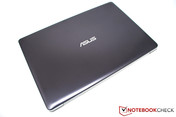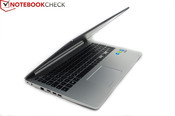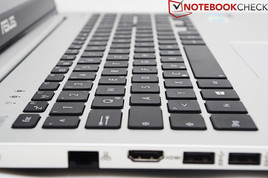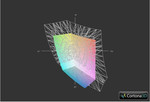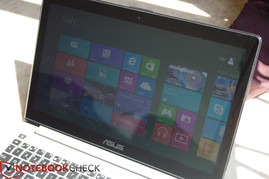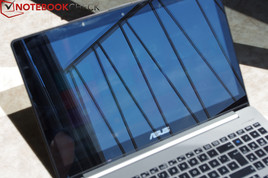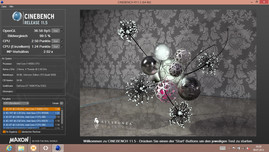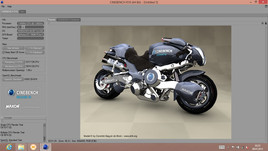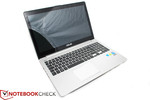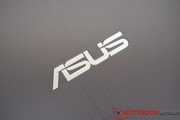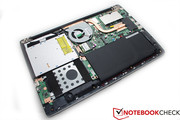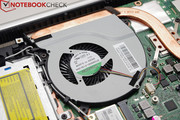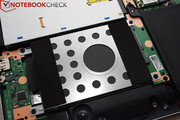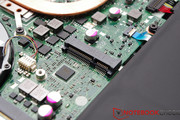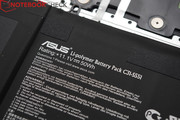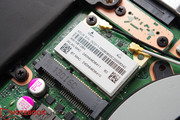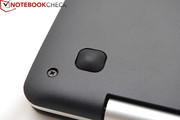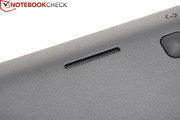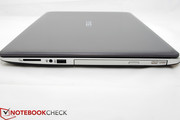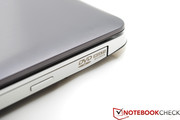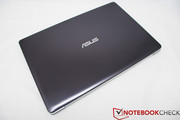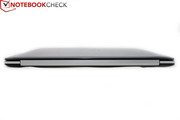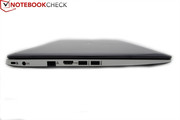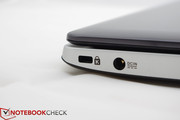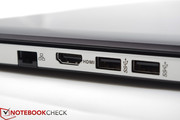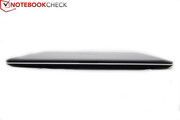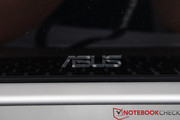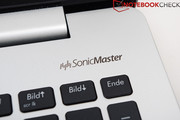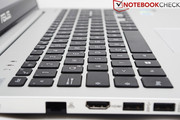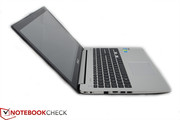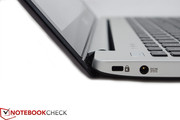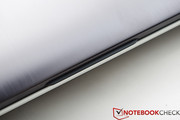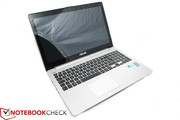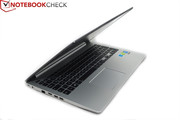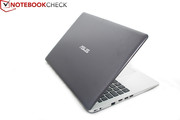Review Asus VivoBook S551LB-CJ026H Ultrabook

For the original German review, see here.
The S551LB is a member of the ultrabook family and features a touchscreen. The tile user interface of the new Windows 8 operating system works perfectly and swiftly with ultrabooks. This is primarily due to the large 15.6-inch screen that the manufacturer installs in its devices. After examining the VivoBook S550CM-CJ038H and S500CA, a Haswell update now follows in the S551LB. The heart is a current Intel Core i7-4500U processor with low power consumption. So that the VivoBook does credit to its family, Asus also equips it with a GeForce GT 740M, which speeds up 3D applications. The buyer gets an appealing total package fused with a large battery, a 500 GB hard drive and 8 GB of working memory.
The casing and input devices have not been modified much and closely resemble those of its bigger brothers. Only a few keys have been rearranged here and the casing altered there. Nevertheless, the S551LB's family resemblance is evident everywhere.
Case
Metal everywhere we look. Asus has put just as much effort into the looks of its new VivoBook S551LB as in its precursors. The differences are insignificant. Nevertheless, the Haswell update shows a few changes. The lid's brushed aluminum surface has been adopted. It gleams in a dark silver that lets a light purple color shine through. The manufacturer's logo adorns the center. Like in the S500CA and S550CM, the base unit is comprised of the finest, matte silver aluminum. Only the chassis' underside is plastic because it is also the maintenance cover. The corners and edges are nicely processed although they are a bit sharp. However, this is barely noticed due to the generously sized wrist rest. Of all parts, we find visible plastic on the display and as if that wasn't enough, Asus uses piano paint favored by cleaning enthusiasts here.
The use of metal reinforces the casing in important places. The wrist rest does not yield under the weight of hands. Picking up the VivoBook is no problem because of its rigidness. The display's hinge also benefits from this. The display closes flush with the casing. Opening the laptop works with light force and is very accurate and smooth. Unfortunately, the device's opening angle of 120° is very low and could make working when sitting in an upright position difficult in some cases.
Connectivity
Not much has changed in the options for connecting peripherals since the VivoBook S550CM. 2 USB 2.0 ports and 1 USB 3.0 port have turned into 2 USB 3.0 ports and 1 USB 2.0 ports. This is better but not yet perfect. We would like to see high-speed ports only nowadays. However, some users will greatly appreciate the added optical DVD drive that gives the VivoBook full multimedia support. The interface distribution quality has deteriorated a bit. The ports were in the rear area of the precursor, but USB 2.0 devices now have to be connected on the front right of our review sample. Users who operate a mouse or the like on this side will frequently touch the plug with their hand.
Communication
Asus VivoBook S51LB can connect to the Wi-Fi router via the installed Atheros AR9485 chip. This was extraordinarily fast in the test. The long range and stable connection surprised us. The Wireless-N 2230 is actually a low-cost solution (no 5 GHz band) but the antennas are apparently so good that the Windows display still showed two bars even at a distance of almost 40 meters to the router and we could browse through the internet in our normal speed. Four bars are displayed at 10 and 15 meters. The signal strength seems to be somewhat better in this non-standardized test than, for example, was the case in HP's EliteBook Folio 9470m with Intel's Centrino Advance-N 6235 (high-end Wi-Fi module; 40 m = 1 bar). Users who want to be faster and on the safe side can connect the S551 to their network switch. This is accomplished with a Gigabit Ethernet port that is based on the Realtek RTL8168 chip. However, not only the way to the World Wide Web has been paved. Other wireless options connect us with our smartphone or external speakers via the installed Bluetooth module. The webcam's resolution of 1280x720 pixels additionally ensures high-def video calls.
Accessories
A look in the box is just as dreary as it was in the older S550CM and S550CA models. Besides a hardware manual and polishing cloth for the screen, nothing else has been added for our review sample.
Maintenance
The VivoBook S551LB's entire bottom tray has to be removed in order to access the laptop's innards. It is secured with many screws. After their removal, the user can access the hard drive, the optical drive and the polymer battery that can be easily replaced in case of damage. The working memory is not accessible since it is soldered to the motherboard. However, it would be possible to use the mSATA slot directly beneath the Wi-Fi module in order to install additional, fast storage. We could not test this option for the lack of hardware.
Warranty
Asus users will know that all laptops come with a 24 month warranty ex-factory. The service includes picking up and returning the device. Users who want to be on the safe side can upgrade the warranty to a total of 3 years. A one-time fee of 75 Euros (~$99) is charged and can be selected via Asus' Service.
Input Devices
Keyboard
As typical for ultrabooks, Asus installs small, flat and above all very quiet keys in the S551LB. Compared with the S550CA and S550CM precursors, little has changed. The arrow keys have been arranged differently and are smaller. This creates a small gap between the keyboard and number pad that was filled with just these keys. We can however underline the great ease with which the keys can be used. Although the stroke is a bit too soft, they are very quiet and provide pleasant feedback.
Touchpad
Some users will get annoyed with the mouse replacement. Its high sensitivity alongside the multi-touch function frequently moves the mouse to unwanted areas. However, the touchpad's size and material are noticed favorably. The mouse buttons are generously sized and feature a crisp use although they are a bit louder than the keyboard's noise. The drop is agreeably short and only moderate force is needed.
Touchscreen
The VivoBook's touchscreen responds quickly and accurately. The 10-finger multi-touch function does not give reason for complaint either. However, many fingerprints will soon be visible around the screen due to the display's glossy bezel.
Display
Asus installs a glare screen in the VivoBook. It has a size of 15.6-inches and a resolution of 1366x768 pixels. Unfortunately, its dark screen is on the same level as the VivoBook S550CA and S550CM models. Only HP's Pavilion Sleekbook TouchSmart 15-b153sg makes a worse impression. Our VivoBook's maximum brightness of 182 cd/m² is not very compelling.
| |||||||||||||||||||||||||
Brightness Distribution: 86 %
Center on Battery: 181 cd/m²
Contrast: 607:1 (Black: 0.3 cd/m²)
ΔE ColorChecker Calman: 5.62 | ∀{0.5-29.43 Ø4.79}
ΔE Greyscale Calman: 4.47 | ∀{0.09-98 Ø5}
40.21% AdobeRGB 1998 (Argyll 1.6.3 3D)
37.23% AdobeRGB 1998 (Argyll 3D)
52.7% sRGB (Argyll 3D)
36.23% Display P3 (Argyll 3D)
Gamma: 2.28
CCT: 7572 K
As seen in the past, the VivoBooks can regain a few points in contrast. Both colors and black hues are vivid and not faded owing to a contrast of 606:1 and a black value of 0.29 cd/m². The multimedia ultrabook's screen can righteously boast with movies and games. The S550CA achieved an identical contrast of 685:1 and a black value of 0.27 cd/m² in its review.
Again, the bluish cast that the screen renders is particularly striking. This is due to the cold color temperature of 7372 Kelvin among other things. In ideal cases, screens reach 6500 Kelvin.
The viewing angles are on a par with what we observed in the previous devices. The image can easily be read from the side without major restrictions. However, the color deviations are enormous depending on the vertical viewing angle. The image dims extremely in larger opening angles and fades quickly in smaller angles.
Performance
VivoBooks are primarily designed for browsing, word processing and rendering video files. Our review sample sports Intel's Core i7-4500U processor from Intel's Haswell family. It makes even more intricate applications possible. The Core i7 is the largest available configuration that Asus can currently offer for this VivoBook. The multimedia laptop should also be apt for gaming alongside 8 GB of working memory and a GeForce GT 740M.
Processor
The key component for computing power is Intel's Core i7-4500U dual-core processor. The Haswell processor clocks with 1.8 GHz on each core and can be increased to a maximum of 3 GHz during load. Both cores additionally exploit two logical units for computing-heavy tasks, which allows processing four operations simultaneously. The older Core i7-3517U, with a 100 MHz faster clock speed, can be considered its direct counterpart.
The processor calculated Cinebench R10 and R11.5 with a clock rate of up to 2.6 GHz. The energy-saving profile has to be set to "High Performance" in order to reach this speed in battery mode. The CPU calculated with low 800 MHz in Asus' Power4Gear and thus the performance in Cinebench R11.5 dropped to 0.52 points. The new Core i7-4500U is at most 8% faster than the older Core i7-3517U used for comparison in the single-core test. Only a few models, like Asus' Zenbook Prime UX31A-C4027H, achieve a similar score as our review sample. However, the tide turns in multi-core operation and the Core i7-4500U lags behind the expectations. Models featuring Intel's Core i7-3517U processor occasionally surpass our review sample by over 10% (Tarox Modula Ultrabook i7). With the Core i7-4500U, the S551LB is on a par with the current Sony Vaio Pro 11. However, the devices are only 5% apart when we compare the S551LB with the older S550CM (Core i5-3317U) in the multi-core benchmark.
System Performance
The system performance leaves us with mixed feelings. The configuration with the Core i7-4500U is quite impressive and the hard drive also convinces with stable rates.
Compared with the older model, the scores of the current S551LB lag behind the expectations. Only 2% separates the contenders from the same manufacturer. In contrast to the S550CA's good 2813 points, our review sample only achieved 2877 points in PCMark 7. This is due to the hard drive installed in the S5510LB that, unlike the S550CA, does not feature an SSD cache. This leads to a lower system performance compared with the competition. Nevertheless, the multimedia score is impressive and is on a par with Acer's Aspire M5-581TG-53314G52Mass which has an SSD cache. The performance is also consistently higher than devices based on the older Intel Core i5-3317U processor.
| PCMark Vantage Result | 6102 points | |
| PCMark 7 Score | 2877 points | |
Help | ||
Storage Devices
Graphics Card
The GeForce GT 740M proves that the VivoBook is not only apt for browsing or word processing in the test. The graphics card is a mid-range model that is built in a 28 nm process by TSMC. The model installed in the VivoBook is based on the new GK208 chip that, like the GK107, relies on 384 Shaders. Unfortunately, the memory bus of 128 bits has now been reduced to 64 bits. The clock frequencies are, however, different. The older GK107 still clocked with 810 MHz and the GeForce GT 740M in the S551LB now clocks with 980 MHz. The graphics chip in our review sample clocked with a high 992 MHz during full CPU and GPU load. However, the clock rate dropped to a permanent 862 MHz after approx. 20 minutes.
The graphics card also features Optimus technology in order to save energy. The processor-integrated graphics unit remains active until a computing-heavy 3D application is started. The integrated HD 4400 from Intel suffices for image output and video rendering. Even current games can be rendered in low resolutions. This adds a few minutes to the VivoBook's battery runtime.
The 3DMark benchmarks recorded a mixed performance for our review sample. The VivoBook S551LB places itself between the GT 640M and GT 735M but remains behind Asus' A56CB-XX053H (Core i5-3317U) with 10% less performance. Our S551LB first surpassed the comparison model in 3DMark 2013 with 4862 points and places itself before Asus A56CB with a lead of 9%. A direct comparison between the internal Intel HD 4400 and the GeForce GT 740M is also interesting. The processor-integrated graphics unit reached an awe-inspiring Cloud Gate score of 3956 points in 3DMark 13. The GeForce GT 740M accomplished 4862 points and thus "only" places itself 22% ahead of the HD 4400.
| 3DMark Vantage P Result | 5709 points | |
| 3DMark 11 Performance | 1834 points | |
| 3DMark Ice Storm Standard Score | 49572 points | |
| 3DMark Cloud Gate Standard Score | 4862 points | |
| 3DMark Fire Strike Score | 925 points | |
Help | ||
| 3DMark 11 - 1280x720 Performance (sort by value) | |
| Asus VivoBook S551LB-CJ026H | |
| Asus VivoBook S300CA | |
| Sony Vaio Duo 13 SVD1321M2E | |
| Asus VivoBook S550CM-CJ038H | |
| Asus A56CB-XX053H | |
| Lenovo IdeaPad Y510p | |
| 3DMark - 1920x1080 Fire Strike Score (sort by value) | |
| Asus VivoBook S551LB-CJ026H | |
| Asus VivoBook S300CA | |
| Sony Vaio Duo 13 SVD1321M2E | |
| Asus A56CB-XX053H | |
| Lenovo IdeaPad Y510p | |
Gaming Performance
In contrast to some other "multimedia ultrabooks", the S551B presents an appealing gaming performance. The GT 740M even accelerates new games in low to medium resolutions smoothly and without difficulties. Less demanding games, such as Diablo 3 or the FIFA series can be rendered stutter-free. However, we were curious to see how it deals with "big" titles like Metro Last Light or BioShock Infinite.
Users who do not have a high demand on games will not have many problems with the S551LB. BioShock Infinite ran with approx. 33 frames in medium settings, which is an acceptable rate. The graphical beauty of Metro Last Light is a heavyweight and Asus' VivoBook had a hard time with it. Last Light was not much fun with an average of 26 frames in very low settings. We also noticed that CPU-heavier games tend to reap in lower rates than comparison models, such as Asus' N56VB-S4050H that sports the same graphics card. The reason for this is the stronger quad-core processor in Asus' 56VB-S4050H.
| low | med. | high | ultra | |
|---|---|---|---|---|
| BioShock Infinite (2013) | 60.7 | 33.03 | 27.4 | |
| Metro: Last Light (2013) | 26.33 | 19.33 | 12.33 | |
| Company of Heroes 2 (2013) | 25.5 | 20.13 | 11.21 |
Emissions
System Noise
Not much has changed in terms of noise compared with Asus' S550CA. The VivoBook that featured the i5-3317U reached a low 30 dB (A) in idle in the test. Our review sample remains on this level. Only the hard drive's subtle noise protrudes with 32.1 dB (A) when it is active. Due to the mechanical parts, a quiet clacking noise is audible during operation. Unfortunately, the VivoBook S5515LB's noise during load worsens from 36.6 to 40 dB (A). However, this is not caused by the processor but due to the graphics card which loads the fan. Nevertheless, this rate is on a very good level and the S551LB remains pleasant even during load.
Noise level
| Idle |
| 30.6 / 30.6 / 30.6 dB(A) |
| HDD |
| 32.1 dB(A) |
| DVD |
| 35.4 / dB(A) |
| Load |
| 40.2 / 40.4 dB(A) |
 | ||
30 dB silent 40 dB(A) audible 50 dB(A) loud |
||
min: | ||
Temperature
The casing's idle temperatures are exemplarily low and impressive with a maximum of 29.9 °C. Both the wrist rest and the keyboard are consistently cool and pleasant. The temperatures are also acceptable during full load although they are a bit higher than in the S550CA. Here the same is true as with the noise: The temperatures reach higher rates due to the dedicated graphics unit. However, Asus has continued its excellent job with the cooling design and the base unit's top stays agreeably cool during load. In particular, the wrist rest is spared from the rear's 48 °C. The user's hands rest safely on the surface with a maximum of 31 °C. The area around the keyboard is also acceptable with a maximum of 41 °C.
We quickly discovered the reason for the good temperature rates. The processor reached a maximum of 65 °C during full load with a clock of 2.3 GHz, which is lower than that of the Core i5-3317U in the S550CA. We did not ascertain thermal throttling in the stress test using Prime95.
(±) The maximum temperature on the upper side is 41.2 °C / 106 F, compared to the average of 36.9 °C / 98 F, ranging from 21.1 to 71 °C for the class Multimedia.
(-) The bottom heats up to a maximum of 48.6 °C / 119 F, compared to the average of 39.2 °C / 103 F
(+) In idle usage, the average temperature for the upper side is 28.4 °C / 83 F, compared to the device average of 31.3 °C / 88 F.
(+) The palmrests and touchpad are cooler than skin temperature with a maximum of 31.3 °C / 88.3 F and are therefore cool to the touch.
(-) The average temperature of the palmrest area of similar devices was 28.7 °C / 83.7 F (-2.6 °C / -4.6 F).
Speakers
The speakers' clearness is acceptable although the trebles sound a bit tinny and there are virtually no mids. The almost complete lack of bass is disappointing. No matter which genre we played - from hip hop to metal - the speakers were not very convincing. Users who want rich sound should definitely use external speakers.
Energy Management
Power Consumption
We only measured 5.9 up to 8.1 watts maximum in idle. This is a very good rate, which is due to Nvidia's Optimus, the ULV processor and the dim screen. Compared with the S550CA that still featured a Core i5-3317U, the consumption has dropped by 2 to 4 watts, which is a very good result. The power consumption first exceeded that of the comparison VivoBook during full load and our S551LB surpassed the older models with 40.7 to 43.8 watts.
| Off / Standby | |
| Idle | |
| Load |
|
Key:
min: | |
Battery Runtime
The VivoBook S551LB's battery runtime convinced us. Intel's Core i7-4500U again shows its efficiency and helps the laptop to an idle runtime of 7:21 hours. That is an additional 26 minutes compared with the VivoBook based on Intel's Core i5-3317U. Our review sample managed for 2:02 hours during load using maximum brightness and lasted 5 minutes longer than the S550CA despite its higher performance.
However, we recorded the biggest difference between the compared models in browsing. Our VivoBook S551LB achieved a long 4:51 hours here, which is an outstanding time. Devices, such as the VivoBook S550CA (3:44 h), HP's Pavilion Sleekbook TouchSmart 15-b153sg (3:09 h) or Acer's Aspire V5-571P-6499 (2:59 h) do not even come close to this rate.
It isn't just the processor that enormously contributes to that. It is also the higher-capacity battery that Asus installs in the review sample. In contrast to the 44 Wh battery in the S550CA, the S551LB now has a 50 Wh battery. Both comparison devices from HP and Acer only sport a 37 Wh battery.
Verdict
Asus launches an impressive Haswell refresh of its VivoBook S551LB. The casing has only been modified slightly and looks just as appealing as its precursors. Asus has also adopted the keyboard and mid-range screen. Although this is rational for the keyboard, it is too bad for the screen. A slightly higher brightness and more accurate color reproduction would not have hurt the VivoBook either.
However, the S551LB has corrected some of the mistakes made by its older brother. The battery runtime is much better and the power consumption convinced us. Intel's Core i7-4500U also sufficiently speeds up all applications although it lagged behind our expectations. The GeForce GT 740M is compelling and turns the VivoBook into a casual gaming machine. Despite a few visible red fields in our benchmarks, the graphics card can render many games when the settings are adapted. We also liked the temperatures and the correspondingly cool casing.
All in all, the VivoBook's total package is successful. An SSD and higher-quality screen would be appreciated in future models though.




